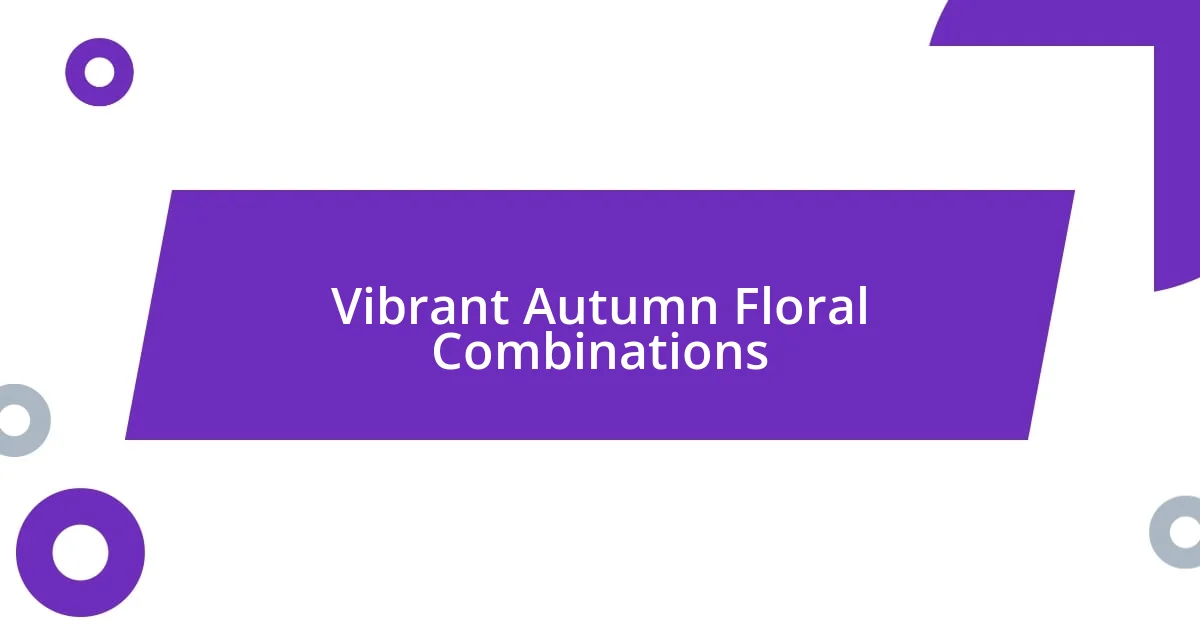Key takeaways:
- Choosing seasonal flowers involves selecting blooms that evoke emotions and complement each other in color and texture.
- Popular flower pairings for each season enhance arrangements, with examples like peonies and iris for spring, and sunflowers with zinnias for summer.
- Tips for maintaining bouquets include using clean tools, frequently changing water, and placing arrangements in a cool spot away from direct sunlight.

Choosing Seasonal Flowers
Choosing seasonal flowers can feel like a delightful puzzle. I remember the first time I noticed how different my garden looked throughout the year; each season brought its own palette. Isn’t it fascinating how flowers not only bloom but also tell a seasonal story?
When selecting flowers, think about what emotions or themes you want to convey. During spring, I gravitate toward tulips and daffodils, as they evoke a sense of renewal and joy. Do you have a favorite memory tied to a particular flower, perhaps a family gathering or a special occasion? These sentiments can guide your choices, making them more meaningful.
Another tip I’ve learned is to consider the colors and textures that complement each other throughout the seasons. Mixing sturdy blooms with delicate ones creates an engaging visual experience. For example, pairing sunflowers with softer asters in late summer brings a dynamic contrast. What visual impressions do you want to create? Ultimately, the flowers you choose should reflect not just the season but also your personal connection to nature.

Understanding Flower Combinations
Understanding flower combinations is all about creating harmony. I remember the thrill of arranging my first bouquet; I learned that certain colors and shapes interact beautifully. A vibrant orange marigold with soft pink cosmos taught me about balance in visual appeal. A well-thought-out combination can evoke specific moods, like serenity or joy, making flower selection an art form.
When pairing flowers, consider the following:
- Color Compatibility: Harmonious colors can enhance the overall aesthetic, while contrasting colors can create visual interest.
- Size and Shape Variation: Mixing blooms of different heights and shapes adds depth and dimension to your arrangements.
- Seasonal Availability: Choose flowers that thrive together in the same season to ensure longevity and freshness.
- Textural Contrast: Pairing delicate petals with bold, structured blooms can create a stunning visual dynamic.
Being mindful of these factors transforms your arrangements from simple bouquets into captivating stories. I always keep a notebook to jot down combinations that inspire me, turning my experience into a creative exploration.

Popular Spring Flower Pairings
When it comes to popular spring flower pairings, I find that few combinations can rival the impact of peonies and iris. This duo brings a vibrant elegance to gardens and bouquets alike. The soft, rounded petals of peonies contrast beautifully with the bold, sword-like leaves of iris, creating a dynamic interplay of shapes and colors. I’ve often watched friends’ faces light up when they receive a bouquet featuring this striking pairing.
Another pairing I adore is hyacinths and tulips. The sweet fragrance of hyacinths merges seamlessly with the classic charm of tulips. I remember the first spring my garden was graced with these flowers; the delightful scent wafting through the air made me feel like I was in a fairytale. Together, they create a sensory experience that embodies the essence of spring. Have you ever stepped outside to inhale the scent of blooming flowers? It’s truly magical.
Lastly, let’s not overlook the charm of anemones and snapdragons. Anemones add a whimsical touch with their delicate, papery blooms, while snapdragons bring height and structure. I find these two flowers elevate any arrangement, making it feel both playful and sophisticated. I often use them in my arrangements for special events, knowing their combined beauty brings smiles to those around me.
| Flower Pairings | Description |
|---|---|
| Peonies & Iris | Elegant contrast of soft peony petals with bold iris leaves. |
| Hyacinths & Tulips | Sweet fragrance of hyacinths merges with classic tulip charm. |
| Anemones & Snapdragons | Whimsical anemones paired with structured snapdragons. |

Bright Summer Flower Mixes
When I think about bright summer flower mixes, one combination that always stands out for me is sunflowers and zinnias. The bold yellow of sunflowers, with their cheerful faces turned toward the sun, creates an uplifting contrast with the vibrant oranges, pinks, and reds of zinnias. Every summer, I remember the joy of walking into a garden bursting with these colors, feeling as if I’d stumbled upon a painter’s palette. Have you ever experienced that burst of happiness when surrounded by such vivid flowers?
Another pairing I can’t resist is the classic combination of dahlias and rudbeckias. The intricate layers of dahlia petals offer an almost sculptural beauty, while the dark centers of rudbeckias provide essential depth. I often find myself captivated by their rich textures and the way they complement each other in arrangements. It’s moments like these that remind me how nature crafts its artistry, evoking feelings of wonder and appreciation. Doesn’t it feel like a celebration when such colors come together to dance in the breeze?
Lastly, consider the freshness of mixed lilies and cosmos for a light, airy feel. The tall, elegant blooms of lilies contrast delightfully with the carefree, daisy-like shape of cosmos. I recall a summer gathering where I arranged these flowers, filling the air with their sweet fragrance and creating an inviting atmosphere. Observing my friends admire the arrangement filled my heart with warmth—it’s extraordinary how flowers can bring us together and spark conversations. Isn’t that the essence of summer?

Vibrant Autumn Floral Combinations
When I think of vibrant autumn floral combinations, the pair of chrysanthemums and asters immediately comes to mind. The round, fluffy blooms of chrysanthemums, with their rich oranges and deep yellows, resonate with the fall colors all around us. I remember visiting a local farmers’ market last autumn and being captivated by a bouquet of these flowers—each a burst of warmth and cheer that perfectly mirrored the crisp air. Have you ever felt the energy of a season captured in a single arrangement?
Another combination that I find particularly enchanting is the classic mix of dahlias and marigolds. The striking configurations of dahlias—sometimes resembling fireworks in full bloom—contrast beautifully with the bold, sunny marigolds. I once arranged these for a fall festival, and the vibrant energy in the air was palpable. As families walked by, their smiles lit up with nostalgia, reminding me of how colors can evoke memories and feelings. Isn’t it fascinating how flowers can stir our emotions so powerfully?
Lastly, I can’t overlook the striking pairing of sunflowers with ornamental kale. While sunflowers stand tall and proud with their sunny faces, ornamental kale adds a unique touch with its ruffled leaves in shades of purple and green. I recall one autumn evening when I crafted a centerpiece using both; the unexpected combination sparked delightful conversations among my guests. It reminded me that simple yet vivid pairings can truly enhance the beauty of any gathering. Have you tried mixing unexpected elements in your floral arrangements? You might discover a new favorite!

Winter Flower Arrangements Guide

Winter Flower Arrangements Guide
When winter arrives, I love creating arrangements that bring a sense of warmth to the chill outside. One of my favorite combinations is the elegant pairing of white amaryllis with soft green eucalyptus. The tall, slender stems of amaryllis symbolize resilience against the frost, while the gentle eucalyptus adds a touch of soothing greenery that reminds me of evergreen trees dusted in snow. Have you ever noticed how certain flowers can evoke the feeling of coziness on a cold day?
Another delightful mix for winter is the traditional red poinsettia combined with delicate white orchids. The rich red of poinsettias represents holiday spirit, and their vibrant presence never fails to lift my mood. I remember one year, placing these flowers at my dining table during family gatherings. Each time I looked at them, I felt gratitude for the moments spent with loved ones. Isn’t it wonderful how a simple floral arrangement can enhance not just a space, but the emotions within it?
For something truly unique, try incorporating dried flowers like lavender with fresh evergreens. The contrast between the rustic, textured dried lavender and the vibrant freshness of evergreens creates a captivating visual experience. I once put together this combination for a winter potpourri, and the blend of earthy scents transported me back to summer fields. It’s remarkable how flowers—whether fresh or dried—can connect us to the seasons that have passed. Have you attempted to blend dried and fresh elements in your floral designs? You might just find yourself crafting seasonal storytelling at your fingertips.

Tips for Long Lasting Bouquets
To ensure your bouquets last longer, always start with clean tools. I vividly remember the first time I neglected this step; my flowers wilted in no time. Now, I make it a point to wash my scissors or clippers thoroughly before cutting any stems. It’s a small act, but it significantly impacts their longevity! Have you ever wondered how something so simple could make such a difference?
Another tip is to change the water frequently. Just last week, I rearranged a bouquet of stunning tulips and noticed they perked up dramatically after I swapped out the murky water for fresh. I often add a pinch of sugar or a splash of lemon juice to the water, too—it’s like a little energy drink for my flowers. Little changes like this can truly breathe life into your arrangements. Why not try it next time?
Lastly, placing your bouquet in a cool spot away from direct sunlight helps tremendously. I learned this the hard way when I left a beautiful arrangement on a sunny windowsill—the flowers drooped like they were ready for a nap! Now, I’m mindful of where I put my bouquets, often choosing a cozy corner with indirect light instead. Have you considered how the placement of your flowers can affect their bloom? It’s a game-changer!














